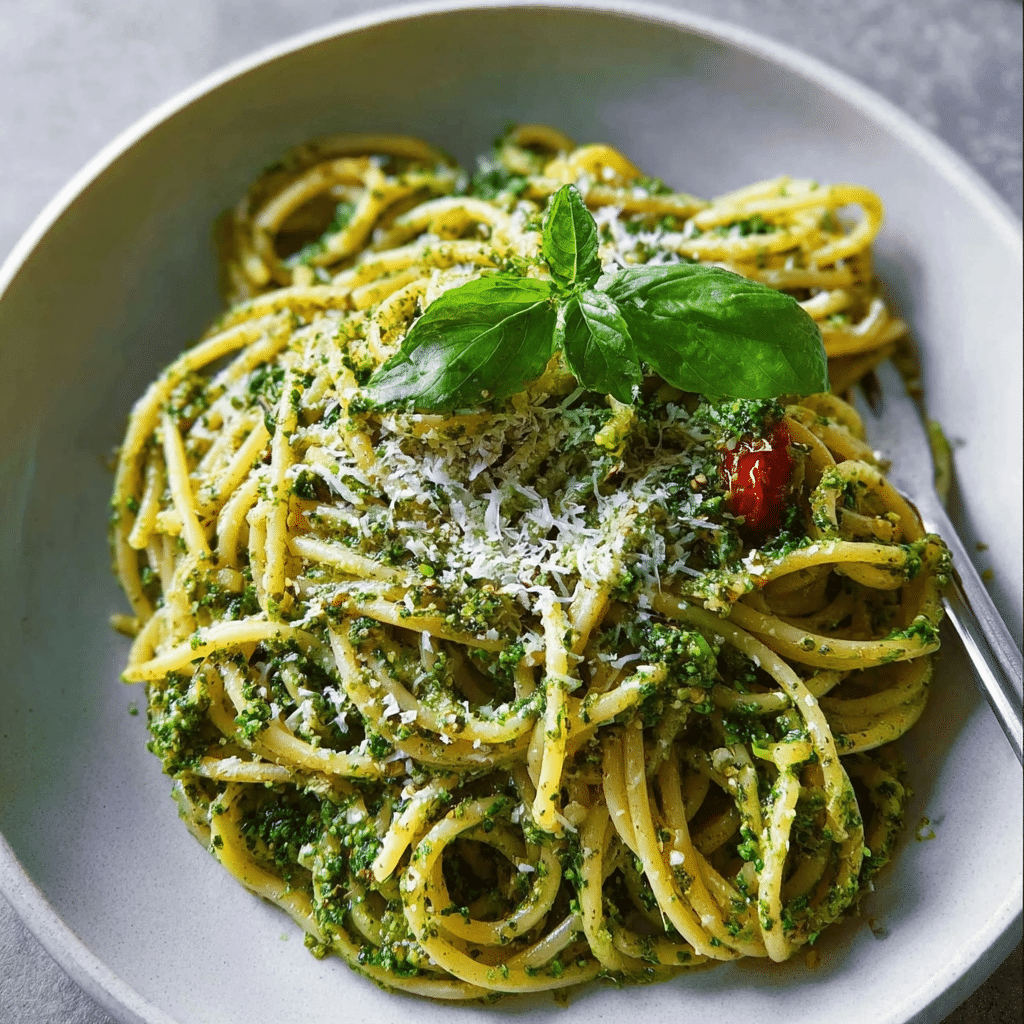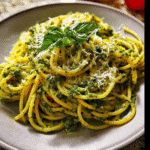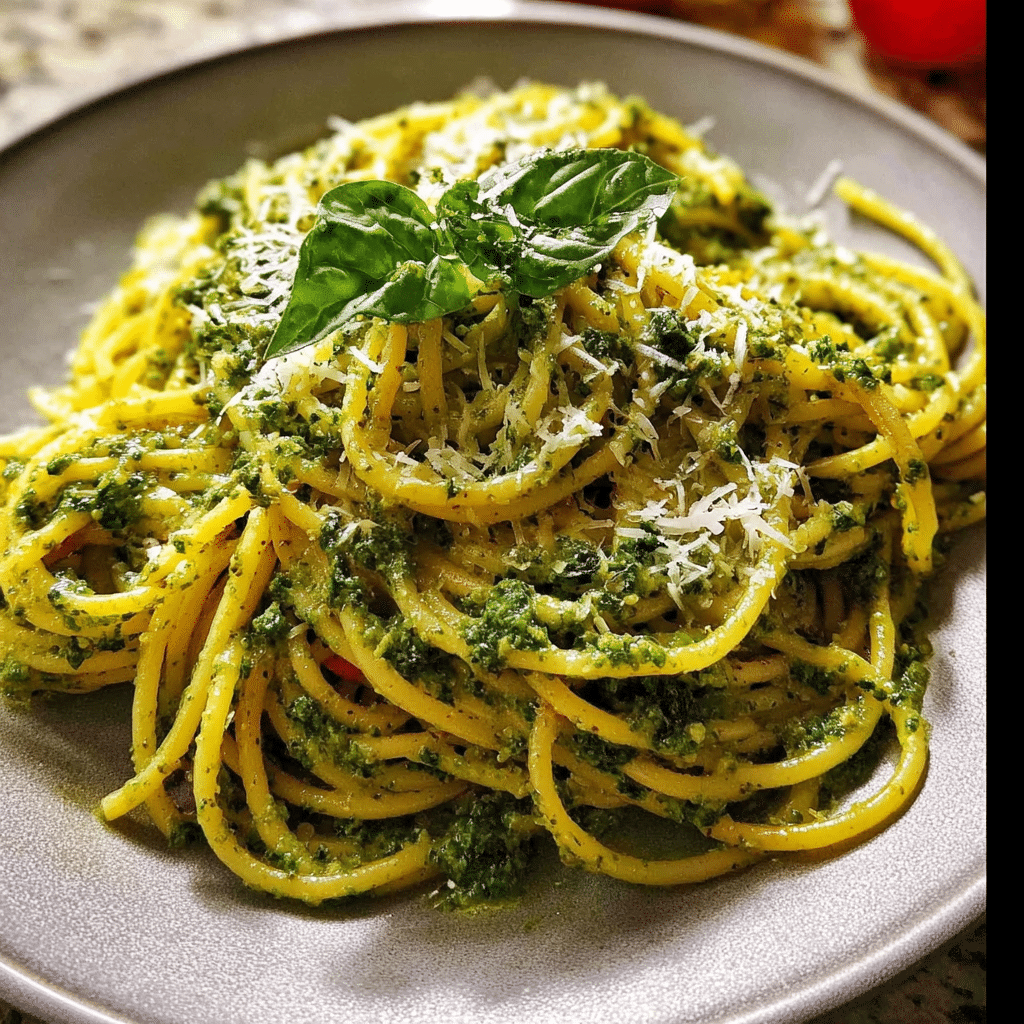Pesto pasta – just saying those two words together makes my heart skip a beat and instantly transports me back to a tiny trattoria in Genoa, where I first tasted authentic basil pesto that changed my life forever. Tired of bland, store-bought pesto that tastes more like green oil than the vibrant, aromatic sauce it should be?
Hi, I’m Emeli from FoodFansy, and after years of perfecting this recipe in both professional kitchens and my own home, I can promise you this: my foolproof method will give you restaurant-quality pesto pasta that’s so fresh and flavorful, you’ll never go back to the jarred stuff again. The secret? It’s not just about the ingredients – it’s about understanding the technique that transforms simple basil leaves into liquid gold.
As someone who’s spent countless hours exploring Italian kitchens and learning from nonnas who’ve been making pesto for generations, I’ve discovered the small details that make all the difference. Today, I’ll share everything from selecting the perfect pasta shape to achieving that silky, emulsified sauce that clings to every strand.
We’ll cover the best basil varieties, pine nut alternatives, cheese combinations, and most importantly, the cooking techniques that ensure your pesto pasta never turns out oily or separated. Plus, I’ll answer all those burning questions about storage, variations, and troubleshooting that every home cook faces.
Why This Pesto Pasta Recipe Works
This pesto pasta recipe has become my go-to for three incredible reasons that make it absolutely foolproof, even for beginners. First, it focuses on flavor balance – the perfect ratio of basil’s peppery bite, garlic’s warmth, pine nuts’ creaminess, and Parmesan’s sharp saltiness creates a harmony that makes every bite unforgettable. Unlike many recipes that overwhelm with garlic or underwhelm with bland herbs, this version hits that sweet spot every single time.
Second, convenience is king in my kitchen, and this recipe delivers. You can have fresh, homemade pesto pasta on the table in just 20 minutes using ingredients you can find at any grocery store. No hunting for exotic herbs or spending hours in the kitchen – just simple, accessible ingredients transformed into something extraordinary. The pesto itself can be made days ahead and stored in the refrigerator, making weeknight dinners a breeze.
Finally, versatility makes this recipe a true kitchen champion. This base pesto pasta works beautifully as a light lunch, elegant dinner party main, or hearty family meal when you add protein. It pairs equally well with delicate angel hair or robust rigatoni, accepts additions like cherry tomatoes and grilled chicken gracefully, and can be adapted for different dietary needs without losing its essential character.
Choosing the Right Pasta for Pesto Pasta
The foundation of exceptional pesto pasta starts with selecting the right pasta shape, and this choice can truly make or break your dish.
Best Pasta Shapes for This Recipe
Pesto pasta shines brightest with shapes that grab and hold onto that precious sauce. Long, thin pasta like linguine and spaghetti are classic choices because their surface area allows the pesto to coat every strand evenly, creating perfect bites where sauce and pasta unite. However, my personal favorite is actually penne or rigatoni – those ridges and hollow centers trap the pesto beautifully, ensuring no flavor goes to waste.
For a more elegant presentation, try trofie, the traditional Ligurian pasta that’s twisted specifically for pesto, or gemelli, whose spiral shape creates little pockets of concentrated flavor. Short pasta shapes like farfalle and orecchiette also work wonderfully, especially when you’re adding vegetables or proteins to your pesto pasta.
Buying Tips for Perfect Pasta
When shopping for your pesto pasta, look for pasta with a slightly rough, matte surface rather than perfectly smooth, shiny pasta. This texture, created during the bronze-die extrusion process, helps the pesto cling better. Quality dried pasta should have a light wheat color and feel firm, not brittle, when you handle the box.
Don’t be afraid to invest in good Italian pasta brands – the difference in texture and flavor is remarkable. Look for packages that specify “bronze-die cut” or “trafilata al bronzo” on the label. If you have access to fresh pasta, that’s wonderful too, but reduce the cooking time significantly and be extra gentle when tossing with pesto.
Smart Substitutions
If you can’t find your preferred shape, almost any pasta works for pesto pasta with slight adjustments. Long pasta can always substitute for other long varieties, and short shapes are generally interchangeable. Whole wheat pasta adds a nutty flavor that complements pesto beautifully, while gluten-free options like rice or chickpea pasta work well if you’re careful not to overcook them.
Ingredients & Prep for Perfect Pesto Pasta
Creating exceptional pesto pasta begins with understanding your ingredients and preparing them properly for maximum flavor impact.
Essential Pesto Components
The star of pesto pasta is, naturally, the basil, and not all basil is created equal. Look for Genovese basil if possible – its smaller leaves pack more concentrated flavor and less bitterness than large-leaf varieties. The leaves should be bright green, aromatic, and free from dark spots. Gently wash and thoroughly dry your basil, as any water will dilute your pesto and potentially cause it to turn dark.
Pine nuts are traditional, but they can be expensive and sometimes turn rancid quickly. Toast them lightly in a dry pan until fragrant – this step is crucial for developing deep, nutty flavor in your pesto pasta. If pine nuts aren’t available, walnuts or blanched almonds make excellent substitutes with their own unique character.
Cheese Selection and Preparation
For authentic pesto pasta, use genuine Parmigiano-Reggiano, aged at least 24 months for the best flavor complexity. The cheese should be freshly grated – pre-grated cheese often contains anti-caking agents that can affect your pesto’s texture. A microplane grater works perfectly for achieving fine, fluffy cheese that incorporates smoothly.
Consider adding a small amount of Pecorino Romano for extra sharpness, but use it sparingly as it can overwhelm the delicate basil. The total cheese amount should balance the other ingredients – you want it to enhance, not dominate, your pesto pasta.
Oil and Seasoning Essentials
Extra virgin olive oil is non-negotiable for quality pesto pasta. Choose a fruity, mild oil rather than an aggressively peppery one that might compete with the basil. The oil should be added gradually while the processor runs, creating an emulsion that makes your pesto creamy rather than separated.
Fresh garlic should be minced finely or grated on a microplane to distribute evenly. Start with less than you think you need – you can always add more, but you can’t take it out. Salt and freshly cracked black pepper should be added at the end, tasting and adjusting until your pesto pasta base is perfectly seasoned.

Step-by-Step Cooking Instructions for Pesto Pasta
Mastering pesto pasta requires attention to timing and technique, but once you understand the process, it becomes second nature.
Pre-Cooking Prep for Pesto Pasta
Begin your pesto pasta journey by bringing a large pot of water to boil – you’ll need at least 6 quarts of water for proper pasta cooking. Salt the water generously; it should taste like seawater. This is your only chance to season the pasta itself, and under-salted pasta will make even the best pesto taste flat.
While the water heats, prepare your pesto. Start by toasting pine nuts in a dry skillet over medium heat, tossing frequently until golden and fragrant, about 3-5 minutes. Let them cool slightly before processing. This toasting step adds incredible depth to your pesto pasta that raw nuts simply can’t provide.
Pesto Making Method for Perfect Pesto Pasta
In your food processor, combine basil leaves, cooled toasted pine nuts, and minced garlic. Pulse in short bursts to avoid overheating the basil, which can cause it to turn dark and bitter. You want a coarse chop at this stage, not a paste.
Add your grated cheeses and pulse again to combine. Now, with the processor running continuously, slowly drizzle in the olive oil. This gradual addition is crucial for creating the emulsified texture that makes pesto pasta silky rather than oily. Stop occasionally to scrape down the sides, ensuring even processing.
Cooking Method for Perfect Pesto Pasta
When your water reaches a rolling boil, add the pasta and cook according to package directions, but start checking for doneness about 2 minutes before the suggested time. Pesto pasta is best when the pasta is perfectly al dente – firm to the bite but not hard in the center.
Before draining, reserve at least 1 cup of the starchy pasta cooking water. This liquid gold will help you achieve the perfect consistency when combining pasta and pesto. The starch in the water helps bind everything together, creating a cohesive pesto pasta dish rather than pasta with sauce sitting on top.
Final Assembly for Restaurant-Quality Pesto Pasta
Drain the pasta but don’t rinse it – you want to retain some surface starch. Immediately return the hot pasta to the pot or transfer to a large serving bowl. Add your pesto and begin tossing gently but thoroughly, ensuring every piece of pasta is coated.
If the mixture seems thick or the pesto isn’t distributing evenly, add pasta water one tablespoon at a time until you achieve a creamy consistency that coats each strand beautifully. The finished pesto pasta should look glossy and cohesive, not dry or separated. Taste and adjust seasoning with salt and pepper as needed.
Pro Tips for Perfect Pesto Pasta
After years of making pesto pasta in professional kitchens and at home, I’ve learned the subtle techniques that separate good from extraordinary.
Avoiding Common Pesto Pasta Mistakes
The biggest mistake I see with pesto pasta is adding the pesto to cold pasta or letting the pasta sit too long before serving. Hot pasta helps the pesto become more fluid and coat better, while cold pasta results in thick, clumpy sauce that doesn’t distribute evenly. Always combine them while the pasta is still steaming hot.
Another common error is making the pesto too far in advance without proper storage. While pesto can be made ahead, cover the surface directly with plastic wrap or drizzle with a thin layer of olive oil to prevent oxidation, which turns your beautiful green pesto pasta sauce an unappetizing brown color.
Never, ever rinse your pasta after cooking when making pesto pasta. The surface starch helps the sauce adhere, and rinsing creates a slippery surface that repels rather than embraces your carefully crafted pesto.
Essential Tool Recommendations for Pesto Pasta Success
A food processor is absolutely essential for proper pesto pasta – while you can make pesto with a mortar and pestle traditionally, a food processor ensures consistent results and saves tremendous time. Choose one with a sharp, quality blade that can handle both the initial chopping and final emulsification.
Invest in a large, heavy-bottomed pot for cooking pasta properly. Thin pots create hot spots that lead to uneven cooking, and small pots don’t provide enough water volume for pasta to move freely. For serving pesto pasta, warm your bowls slightly – this keeps the dish at optimal temperature longer.
A microplane grater is invaluable for both garlic and cheese preparation. It creates much finer, more evenly distributed results than traditional graters, leading to smoother, more professional pesto pasta every time.
Storage and Reheating Wisdom
Fresh pesto pasta is always best served immediately, but leftovers can be successfully reheated with the right technique. Add a splash of pasta water or olive oil and gently reheat in a skillet over low heat, tossing constantly to prevent the pesto from separating or the pasta from becoming mushy.
Store leftover pesto separately when possible, covering the surface with plastic wrap pressed directly onto the sauce. Properly stored pesto keeps for up to a week in the refrigerator, making it easy to create quick pesto pasta meals throughout the week.
Flavor Variations for Creative Pesto Pasta
The beauty of pesto pasta lies in its adaptability – once you master the basic technique, countless variations become possible.
Spicy Pesto Pasta Variations
Transform your pesto pasta into a fiery delight by adding red pepper flakes during the pesto-making process, or incorporate fresh jalapeños or serranos for heat with more complex flavor. Calabrian chilies, available in specialty stores, add a smoky heat that’s particularly wonderful with pesto pasta.
For a more sophisticated heat, try adding chipotle peppers in adobo sauce – just a small amount provides smoky warmth without overwhelming the basil. Alternatively, finish your pesto pasta with a drizzle of good-quality chili oil for heat that builds gradually with each bite.
Dietary-Friendly Pesto Pasta Options
Creating keto-friendly pesto pasta is simple – substitute zucchini noodles, shirataki noodles, or hearts of palm pasta for traditional wheat pasta. The pesto itself is naturally low-carb and can be made even richer by increasing the olive oil slightly to compensate for the different pasta texture.
For dairy-free pesto pasta, replace Parmesan with nutritional yeast, which provides umami depth, or use cashew-based cheese alternatives. Vegan versions benefit from adding a small amount of miso paste for the complexity that cheese normally provides.
Global-Inspired Pesto Pasta Fusion
Asian-inspired pesto pasta works beautifully with cilantro or Thai basil replacing traditional basil, and cashews or peanuts instead of pine nuts. Add a touch of sesame oil and soy sauce for umami depth that transforms familiar pesto pasta into something entirely new.
Mediterranean variations might include sun-dried tomatoes processed into the pesto, or Greek-inspired versions using a combination of basil and oregano with feta cheese. Mexican-influenced pesto pasta can incorporate cilantro, pepitas (pumpkin seeds), and a squeeze of lime for brightness.
| Variation | Main Ingredient Swap | Additional Flavors | Best Pasta Shape |
|---|---|---|---|
| Spicy Calabrian | Add Calabrian chilies | Roasted garlic | Bucatini |
| Asian Fusion | Thai basil, cashews | Sesame oil, soy sauce | Rice noodles |
| Mediterranean | Sun-dried tomatoes | Kalamata olives, feta | Penne |
| Mexican-Inspired | Cilantro, pepitas | Lime juice, jalapeño | Shells |
| Keto-Friendly | Zucchini noodles | Extra olive oil | Spiralized vegetables |
| Vegan Delight | Nutritional yeast | Miso paste, cashews | Any shape |
Serving Suggestions for Memorable Pesto Pasta
Elevating your pesto pasta from simple weeknight dinner to memorable meal requires thoughtful accompaniments and presentation.
The key to exceptional pesto pasta presentation lies in keeping the focus on the vibrant green sauce while adding complementary colors and textures. Serve in warmed bowls to maintain temperature, and consider garnishing with halved cherry tomatoes for color contrast, extra pine nuts for texture, and a final sprinkle of freshly grated Parmesan.
Wine pairings for pesto pasta should complement rather than compete with the herbaceous flavors. Crisp white wines like Vermentino, Sauvignon Blanc, or Pinot Grigio work beautifully, their acidity cutting through the richness of the olive oil and cheese. For red wine lovers, light-bodied options like Chianti Classico or Barbera d’Alba provide enough structure without overwhelming the delicate basil flavors.
Side dishes should remain simple to let your pesto pasta shine. A basic mixed greens salad dressed with lemon vinaigrette provides fresh contrast, while warm crusty bread helps soak up any precious pesto that might remain in the bowl. Grilled vegetables like zucchini, bell peppers, or asparagus add smokiness without competing flavors.
FAQs About Perfect Pesto Pasta
Understanding common pesto pasta concerns helps ensure success every time you make this beloved dish.
Can I make pesto pasta with frozen basil? While fresh basil creates the best pesto pasta, frozen basil can work in a pinch. Thaw it completely and drain any excess water thoroughly before processing. The texture won’t be quite as bright, but the flavor remains good. However, avoid using dried basil – it simply cannot provide the fresh, vibrant taste that makes pesto pasta special.
How do I fix separated or oily pesto pasta? If your pesto pasta looks oily rather than creamy, the pesto likely separated. Fix this by adding a small amount of pasta cooking water and tossing vigorously – the starch helps re-emulsify the sauce. For future batches, add the olive oil more slowly during processing and ensure all ingredients are at room temperature.
Is homemade pesto pasta safe during pregnancy? The main concern with pesto pasta during pregnancy involves the raw garlic and unpasteurized cheese. Using pasteurized Parmesan eliminates cheese concerns, and the small amount of raw garlic in pesto is generally considered safe. However, always consult your healthcare provider about dietary concerns during pregnancy.
Can I freeze pesto for future pesto pasta? Yes, pesto freezes well, though the texture changes slightly upon thawing. Freeze in ice cube trays for portion control, then transfer to freezer bags. Frozen pesto works perfectly for pesto pasta – just thaw what you need and add a splash of fresh olive oil to restore smoothness.
Why does my pesto pasta turn brown? Oxidation causes browning in pesto pasta when basil comes into contact with air. Prevent this by covering pesto with plastic wrap pressed directly onto the surface, or drizzling with olive oil. Adding a small amount of lemon juice can also help preserve color, though it will slightly alter the traditional flavor profile.
Conclusion
Creating perfect pesto pasta is truly one of life’s simple pleasures, and now you have all the knowledge needed to make restaurant-quality results in your own kitchen. From selecting the right basil and pasta shapes to mastering the emulsification technique that creates silky, clinging sauce, these techniques will transform your weeknight dinners and impress your guests.
The beauty of pesto pasta lies not just in its incredible flavor, but in its versatility and the joy of sharing it with others. Whether you’re making a quick solo lunch or preparing dinner for family and friends, this dish never fails to bring smiles and satisfaction.
Fire up your food processor and grab that best olive oil – it’s time to create some pesto pasta magic tonight! Your kitchen will smell absolutely incredible, and you’ll wonder why you ever settled for store-bought pesto.
Join the thousands of home cooks who’ve discovered the joy of homemade pesto pasta through FoodFansy! Once you taste the difference that fresh, properly made pesto makes, you’ll understand why this simple dish has captured hearts across the globe for generations.
Ready for your next culinary adventure? Try our [Ultimate Carbonara Guide] or explore our [Fresh Herb Garden series] to expand your pasta repertoire and bring even more Italian-inspired joy to your table. Buon appetito!
If you enjoyed this recipe, be sure to share it with your friends or save it for later!
I’d love to see your unique twist—feel free to post your photos on Pinterest!
Print
Pesto Pasta: 7 Secrets to Irresistible Homemade Italian Magic
- Total Time: 25 minutes
- Yield: 4 servings
- Diet: Vegetarian
Description
This Pesto Pasta is the ultimate quick and flavorful meal that comes together in minutes! Made with tender al dente pasta and tossed in a vibrant, garlicky basil pesto, it’s a fresh and herby dish perfect for busy weeknights or a light weekend lunch. Add grilled chicken, shrimp, or veggies to make it a hearty main, or serve it as a simple side. Bursting with flavor and ready in under 30 minutes!
Ingredients
1 pound pasta (spaghetti, linguine, or penne work well)
1/2 cup fresh basil leaves, packed
1/4 cup pine nuts
2 cloves garlic, minced
1/2 cup grated Parmesan cheese, plus more for serving
1/4 cup extra virgin olive oil, plus more for drizzling
Salt and freshly ground black pepper to taste
Optional: 1/4 cup grated Pecorino Romano cheese
Optional: Cherry tomatoes, halved, for garnish
Optional: Cooked chicken or shrimp for added protein
Optional: Red pepper flakes for a touch of heat
Instructions
Toast pine nuts in a dry skillet over medium heat for 3-5 minutes, tossing frequently, until lightly golden brown and fragrant. Alternatively, toast in the oven at 350°F (175°C) for 5-7 minutes, watching carefully. Let cool slightly.
In a food processor, combine basil leaves, toasted pine nuts (or untoasted), and minced garlic. Pulse to coarsely chop.
Add Parmesan cheese (and Pecorino Romano, if using) to the food processor. Pulse to combine.
With the food processor running, slowly drizzle in olive oil until the pesto reaches your desired consistency.
Season with salt and pepper to taste.
Fill a large pot with water (at least 6 quarts). Add a generous pinch of salt. Bring to a rolling boil.
Add pasta and cook according to package directions (8-12 minutes) until al dente.
Before draining, reserve about 1 cup of pasta water.
Drain pasta in a colander (do not rinse).
Add drained pasta back to the pot. Add pesto and toss gently to coat.
If the sauce is too thick, add pasta water, one tablespoon at a time, until the desired consistency is reached.
Taste and adjust seasonings as needed.
Serve pesto pasta immediately.
Garnish with extra Parmesan cheese, halved cherry tomatoes, and a drizzle of olive oil. Add red pepper flakes for heat. Toss with cooked chicken or shrimp, if using.
Notes
This Pesto Pasta is a go-to in my kitchen for its simplicity and bold, fresh flavor. Whether you’re using homemade or store-bought pesto, the result is always delicious. It’s incredibly versatile—enjoy it on its own, toss in some grilled chicken or roasted veggies, or even serve it cold as a pasta salad. For the best flavor, reserve a little pasta water to help the pesto cling to every bite!
- Prep Time: 10 minutes
- Cook Time: 15 minutes
- Category: Main Dish / Side Dish
- Method: Stovetop
- Cuisine: Italian
Nutrition
- Serving Size: 1 bowl (~1¼ cups)
- Calories: 450 kcal
- Sugar: 2g
- Sodium: 340mg
- Fat: 24g
- Saturated Fat: 4g
- Unsaturated Fat: 18g
- Trans Fat: 0g
- Carbohydrates: 45g
- Fiber: 2g
- Protein: 11g
- Cholesterol: 10mg

